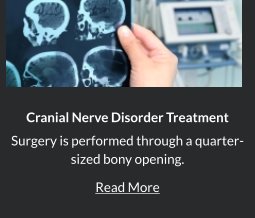FAQ
Find below a list of FAQ (Frequently Asked Questions) about Brain Surgery and Spine Surgery. The answers provided do not replace the advice of your physician. It is important that you seek medical advice directly from your physician about your condition and procedures.
General FAQ
- We need your complete medical history
- We will ask you to provide a copy of your medication list
- We would like to have the contact information for your primary doctor
- We need a copy (usually on a CD) of your most recent MRI or CT scan
Brain Surgery
- Conventional Craniotomy
- Endoscopic Endonasal Approach
- Endoscopic Transsphenoidal Surgery
- CyberKnife® Robotic Radiosurgery
- Minimally Invasive Keyhole Brain Surgeries
- Retromastoid Approach
- Supraorbital Eyebrow Craniotomy
Spine Surgery
- Anterior Cervical Discectomy and Fusion
- Cervical and Lumbar Spine Arthroplasty
- Cervical and Lumbar Kyphoplasty
- Posterior Cervical Fusion with Instrumentation
Brain Surgery FAQ
Most patients are instructed to avoid strenuous activities that increase pressure of spinal fluid inside the head (bending, lifting, straining, nose-blowing) for about a month after brain surgery to minimize the risk of a spinal fluid leak. A spinal fluid leak is a clear fluid that drains from the nose. If spinal fluid leak occurs, your neurosurgeon can address this using endoscopic surgical techniques. Most patients will also notice a decrease in smell and taste several months after the EEA procedure due to decreased air flow through the nose, which often improves as healing occurs.
We prefer not to force one angle of surgical approach. If a specific tumor can be totally removed using a single approach, such as endonasal surgery, then we will use that approach. However, if part of the tumor is located on the other side of important structures, such as blood vessels and nerves, we prefer to remove the residual portion using a different corridor, which can be a focused traditional approach. There are also situations in which only a focused traditional approach is necessary.
Our surgeons are experienced in all types of skull base surgery and utilize a variety of surgical approaches and techniques to design the best operation for each patient.
Spine Surgery FAQ
With any surgical procedures, it is important to trust your surgeon. Dr. Robert Louis is an award-winning and fellowship-trained Orange County Brain and Spine Surgeon. He is an advocate of minimally invasive surgery for its benefits to the patients, and strives to make the experience comfortable and with the best possible.
After undergoing minimally invasive spine surgery, patients are are advised to avoid lifting heavy objects for several weeks or months to avoid post-operative pain. It is helpful to arrange and place regularly used items within easy reach to reduce bending or reaching.
















